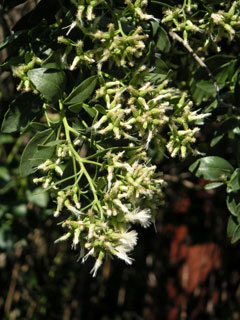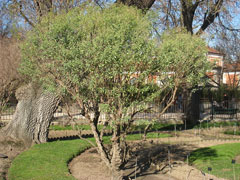 |
|
http://commons.wikimedia.org/wiki/User:Jean-Jacques_MILAN |
 |
| http://commons.wikimedia.org/wiki/User:Daderot |
Translate this page:
Summary
Bloom Color: White.
Main Bloom Time: Early fall, Late fall, Mid fall. Form: Upright or erect, Vase.
Physical Characteristics

 Baccharis halimifolia is a deciduous Shrub growing to 3.5 m (11ft) by 3.5 m (11ft) at a medium rate.
Baccharis halimifolia is a deciduous Shrub growing to 3.5 m (11ft) by 3.5 m (11ft) at a medium rate.
See above for USDA hardiness. It is hardy to UK zone 5. It is in flower in October. The species is dioecious (individual flowers are either male or female, but only one sex is to be found on any one plant so both male and female plants must be grown if seed is required). and is pollinated by Insects. The plant is not self-fertile.
Suitable for: light (sandy), medium (loamy) and heavy (clay) soils, prefers well-drained soil and can grow in nutritionally poor soil. Suitable pH: mildly acid, neutral and basic (mildly alkaline) soils and can grow in very alkaline and saline soils.
It cannot grow in the shade. It prefers dry or moist soil. The plant can tolerate maritime exposure.
UK Hardiness Map
US Hardiness Map
Synonyms
Plant Habitats
Woodland Garden Sunny Edge; Hedge;
Edible Uses
References More on Edible Uses
Medicinal Uses
Plants For A Future can not take any responsibility for any adverse effects from the use of plants. Always seek advice from a professional before using a plant medicinally.
Demulcent
The plant is used as a palliative and demulcent in consumption and cough[207].
References More on Medicinal Uses
The Bookshop: Edible Plant Books
Our Latest books on Perennial Plants For Food Forests and Permaculture Gardens in paperback or digital formats.

Edible Tropical Plants
Food Forest Plants for Hotter Conditions: 250+ Plants For Tropical Food Forests & Permaculture Gardens.
More

Edible Temperate Plants
Plants for Your Food Forest: 500 Plants for Temperate Food Forests & Permaculture Gardens.
More

More Books
PFAF have eight books available in paperback and digital formats. Browse the shop for more information.
Shop Now
Other Uses
Fuel Hedge Hedge Soil stabilization
A good fast-growing hedge for exposed maritime conditions[11, K]. It retains its leaves into the new year but is rather bare in late winter[K]. Plants have an extensive root system and can be grown on sand or thin coastal soils in order to bind the soil[200]. Resinous secretions on the leaves and wood make this a useful fuel[11]. It is a fairly small plant though and would not be a very productive source.
Special Uses
Hedge Hedge
References More on Other Uses
Cultivation details
Landscape Uses:Seashore. Succeeds in a sunny position in any well-drained soil[11, 188], from heavy clays to pure sands[113]. Tolerates saline conditions and dry soils[188, 200]. A useful shrub for coastal situations, resisting maritime exposure[11]. Plants are hardy to about -15°c[200]. A fast-growing plant, it is very tolerant of pruning and can be cut right back to the base if required[K]. The presence of this plant growing wild was supposed to indicate areas where oil might be found[207]. Dioecious. Male and female plants must be grown if seed is required. Special Features:North American native, All or parts of this plant are poisonous, Wetlands plant, Attractive flowers or blooms.
References Carbon Farming Information and Carbon Sequestration Information
Temperature Converter
Type a value in the Celsius field to convert the value to Fahrenheit:
Fahrenheit:
The PFAF Bookshop
Plants For A Future have a number of books available in paperback and digital form. Book titles include Edible Plants, Edible Perennials, Edible Trees,Edible Shrubs, Woodland Gardening, and Temperate Food Forest Plants. Our new book is Food Forest Plants For Hotter Conditions (Tropical and Sub-Tropical).
Shop Now
Plant Propagation
Seed - no pre-treatment is required[113]. Surface sow in pots a cold frame in the spring, do not let the compost dry out. Germination usually takes place within 1 - 2 weeks[113]. When they are large enough to handle, prick the seedlings out into individual pots and grow them on in the cold frame for at least their first winter. Plant them out into their permanent positions in late spring or early summer, after the last expected frosts. Cuttings of half-ripe wood, July/August in a frame. Very easy[K]. Cuttings of mature wood of the current seasons growth, November in a frame. Easy[K].
Other Names
If available other names are mentioned here
Native Range
NORTHERN AMERICA: Canada (Nova Scotia), United States (Connecticut, Massachusetts, New Jersey, New York, Pennsylvania, Rhode Island, Oklahoma, Alabama, Arkansas, Delaware, Florida, Georgia, Louisiana, Maryland, Mississippi, South Carolina, Virginia, Texas), Mexico (Nuevo León, San Luis Potosí, Tamaulipas, Veracruz de Ignacio de la Llave) SOUTHERN AMERICA: Bahamas, Cuba
Weed Potential
Right plant wrong place. We are currently updating this section.
Please note that a plant may be invasive in one area but may not in your area so it's worth checking.
Conservation Status
IUCN Red List of Threatened Plants Status :

Growth: S = slow M = medium F = fast. Soil: L = light (sandy) M = medium H = heavy (clay). pH: A = acid N = neutral B = basic (alkaline). Shade: F = full shade S = semi-shade N = no shade. Moisture: D = dry M = Moist We = wet Wa = water.
Now available:
Food Forest Plants for Mediterranean Conditions
350+ Perennial Plants For Mediterranean and Drier Food Forests and Permaculture Gardens.
[Paperback and eBook]
This is the third in Plants For A Future's series of plant guides for food forests tailored to
specific climate zones. Following volumes on temperate and tropical ecosystems, this book focuses
on species suited to Mediterranean conditions—regions with hot, dry summers and cool, wet winters,
often facing the added challenge of climate change.
Read More
Expert comment
Author
L.
Botanical References
1143200
Links / References
For a list of references used on this page please go here
Readers comment
| Add a comment |
|
If you have important information about this plant that may help other users please add a comment or link below. Only comments or links that are felt to be directly relevant to a plant will be included. If you think a comment/link or information contained on this page is inaccurate or misleading we would welcome your feedback at [email protected]. If you have questions about a plant please use the Forum on this website as we do not have the resources to answer questions ourselves.
* Please note: the comments by website users are not necessarily those held by PFAF and may give misleading or inaccurate information.
To leave a comment please Register or login here All comments need to be approved so will not appear immediately.
|
Subject : Baccharis halimifolia
|
|
|
|